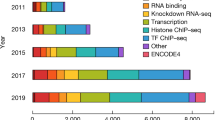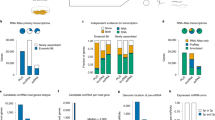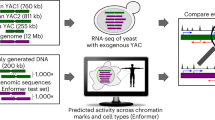Abstract
We have searched the human genome for genes encoding new proteins that may be involved in three nuclear gene expression processes: transcription, pre-messenger RNA splicing and polyadenylation. A plethora of potential new factors are implicated by sequence in nuclear gene expression, revealing a substantial but selective increase in complexity compared with Drosophila melanogaster and Caenorhabditis elegans. Although the raw genomic information has limitations, its availability offers new experimental approaches for studying gene expression.
Similar content being viewed by others
Main
The availability of the human and other genome sequences will revolutionize all fields of biomedical research. But, as the genome is itself the object of gene expression, the impact may be particularly profound for those of us studying this process. Here we preview what the human genome has to offer to those interested in gene expression.
Gene expression comprises various events from the initial transcription of a gene in the nucleus to the translation of mRNA in the cytoplasm. Here we focus on three steps that occur in the nucleus: transcription, pre-mRNA splicing and 3′ end formation. All three involve the recognition of a nucleic acid (DNA or RNA) that serves as a scaffold for a multiprotein complex in which the relevant reaction (transcription, splicing or 3′ end formation) occurs. Research in each is aimed at identifying all the relevant components and elucidating how the reaction is controlled.
General transcription factors
Factors involved in the transcription of eukaryotic protein-coding genes by RNA polymerase II fall into two groups: general (or basic) transcription factors (GTFs) and transcriptional activators. GTFs are required for accurate transcription initiation in vitro1. They include RNA polymerase II itself and at least six GTFs: TFIID, TFIIA, TFIIB, TFIIE, TFIIF and TFIIH. The GTFs assemble on the promoter to form a preinitiation complex (PIC). Of the GTFs, TFIID is the primary sequence-specific DNA-binding component; it initiates PIC assembly by interaction with the TATA box. TFIID is composed of the TATA-box-binding protein (TBP) and multiple TBP-associated factors (TAFs)2. This basic transcription machinery has, in general, been highly conserved from yeast to human.
We have searched the human genome sequence for GTFs. Consistent with the Drosophila, C. elegans and Saccharomyces cerevisiae genomes3, the human genome contains single-copy genes encoding the components of RNA polymerase II, TFIIB, TFIIE, TFIIF and TFIIH, in general without evidence for related genes (see Supplementary Information Table 1). A potentially important exception is the presence of three genes related to cdk7, a cyclin-dependent kinase that is associated with TFIIH4.
We found gene sequences related to many of the TFIID subunits, including TBP, TFIIA and several TAFs, indicating that the potential diversity of human TFIID is much greater than that of Drosophila3 (see Supplementary Information Table 1). For example, we identified six human genes related to TAF32, but no Drosophila genes related to the homologous TAF40. It was thought that all metazoans possess a single gene for TBP, with a second gene encoding a TBP-like factor (TLF). Unusually, Drosophila contains a third TBP-related gene (TRF1)5. However, our searches reveal that humans also have a third TBP-related sequence on chromosome 14 (see Supplementary Information Fig. 1).
Transcriptional activators
Transcriptional activity is strongly stimulated by promoter-specific activators. In general, these are sequence-specific DNA-binding proteins whose recognition sites are present in target promoters. Activators have been classified into families on the basis of their DNA-binding domains. A search of the human genome sequence revealed more than 2,000 hypothetical genes that encode transcriptional activators (Fig. 1). The C2H2 zinc finger proteins form the largest family (around 900 members), and this is also the largest family of activators in Drosophila, C. elegans and S. cerevisiae. There are around twice as many basic region leucine zipper (bZIP) proteins, nuclear receptors and helix–loop–helix proteins in the human genome as in the Drosophila genome, and 5–10 times more than in the C. elegans and S. cerevisiae genomes (Fig. 1).
The relative sizes of transcriptional activator families among Homo sapiens, D. melanogaster, C. elegans and S. cerevisiae are indicated, derived from an analysis of eukaryotic proteomes using the INTERPRO database, which incorporates Pfam, PRINTS and Prosite. The transcription factors families shown are the largest of their category out of the 1,502 human protein families listed by the IPI.
We performed more extensive searches on the bZIP protein superfamily of transcriptional activators. We have aligned these new bZIP proteins on the basis of sequence relatedness to existing members of the bZIP subfamilies, such as Jun, Fos, ATF, CREB and c/EBP (see Supplementary Information Fig. 2). This revealed 18 new bZIP genes, primarily belonging to the Fos and CREB families. Three new genes belong to the small TEF/HLF family, which shares strong similarity with the C. elegans gene ces-2, which is involved in the control of programmed cell death6,7. This search illustrates how the human genome sequence will provide many new factors that may be involved in gene expression, although their roles remain unknown.
Pre-mRNA splicing
Pre-mRNA splicing occurs in a large, dynamic complex, the spliceosome. To assemble the spliceosome, four small nuclear ribonucleoprotein (snRNP) particles (U1, U2, U5 and U4/U6) and many non-snRNP proteins interact with pre-mRNA in an ordered pathway8,9. In metazoans, spliceosome assembly begins with recognition of the 5′ splice site by U1 snRNP, and of the polypyrimidine (Py)-tract by the U2 snRNP auxiliary factor, U2AF10.
We have searched the human genome sequence for several protein-splicing factors that act early during spliceosome assembly. The results reveal significantly greater complexity than is found in Drosophila11 (see Supplementary Information Table 2). Of particular interest are several new genes closely related to the small subunit of U2AF, U2AF35 (see Supplementary Information Fig. 3).
Polyadenylation
Eukaryotic mRNAs have a 3′ poly(A) tail, around 200 nucleotides long, which is added post-transcriptionally following endonucleolytic cleavage of the pre-mRNA. Addition of poly(A) is directed by a polyadenylation sequence, AAUAAA, located 10–30 bases upstream of the polyadenylation site. Polyadenylation requires various protein components, including a cleavage/polyadenylation specificity factor (CPSF), a cleavage stimulatory factor (CstF), other cleavage factors and a poly(A) polymerase (PAP)12. Several poly(A)-binding proteins (PABs) bind to the mature poly(A) tail.
We identified genes related to factors involved in mRNA 3′ end formation, including PAP and PAB (see Supplementary Information Table 3). It was known that there were multiple, alternatively spliced variants of PAP, but the existence of several PAP-related gene sequences was unexpected and increases the potential diversity of this enzyme. These results suggest that the polyadenylation machinery of humans is more complex than that of Drosophila.
Limitations of the genomic information
Although these searches highlight the power of the new genomic information, they also reveal important limitations. In particular, the existence of a related gene sequence does not mean that there is a corresponding protein: the sequence could be a non-expressed pseudogene. Indeed, some new gene sequences contain stop codons or lack introns. We know that some of the related gene sequences are expressed, however, as they are present in expressed sequence tag (EST) databases. Even if a related sequence is an expressed gene, we do not know whether the two related genes are simultaneously expressed in the same cell, or are differentially expressed—for example, in a tissue- or development-specific manner. Expression studies will be required to complement genomic information. A final caveat is that many of the factors are components of multi-subunit complexes. Sometimes the same factor is present in multiple complexes whose activities differ substantially. Thus, the full value of the genomic information can be realized only when it is coupled with appropriate biochemical studies.
New approaches for studying gene expression
Full eukaryotic genome sequences will allow new experimental strategies to study gene expression. In the ‘classical’ pre-genomic strategy, factors involved in gene expression were identified through biochemical or genetic experiments that focused on a specific gene expression process (for example, a transcription pathway). The human genome sequence contains many new factors whose sequences suggest roles in gene expression but whose precise activities and functions are unknown. Therefore, a ‘post-genomic’ approach can start with the new gene (or its protein product) and determine its activity and the pathway in which it participates.
Consider the new bZIP proteins. Clues to the biological processes in which they participate may be obtained by determining their tissue expression patterns, elucidating their DNA binding specificities13 or mapping their chromosomal sites of occupancy14. Ultimately, understanding the function of a transcriptional activator will require identification of the genes that it controls. This requires derivation of appropriate cell lines or animal models in which the protein can be expressed (or inactivated) in a regulated fashion. The consequences of its expression (or inactivation) on the transcription of specific genes is then monitored. In the most powerful version of this approach, target gene transcription can be assayed in parallel using high-density DNA microarrays15.
By performing focused searches of the draft human genome sequence, we have identified many new factors that may be involved in transcription, splicing and mRNA 3′ end formation. The increased complexity of the human gene expression machinery implies that gene expression may be particularly important in shaping human development and physiology.
References
Orphanides, G., Lagrange, T. & Reinberg, D. The general transcription factors of RNA polymerase II. Genes Dev. 10, 2657–2683 (1996).
Burley, S. K. & Roeder, R. G. Biochemistry and structural biology of transcription factor IID (TFIID). Annu. Rev. Biochem. 65, 769–799 (1996).
Aoyagi, N. & Wassarman, D. A. Genes encoding Drosophila melanogaster RNA polymerase II general transcription factors: diversity in TFIIA and TFIID components contributes to gene-specific transcriptional regulation. J. Cell. Biol. 150, F45–F49 (2000).
Coin, F. & Egly, J. M. Ten years of TFIIH. Cold Spring Harb. Symp. Quant. Biol. 63, 105–110 (1998).
Berk, A. J. TBP-like factors come into focus. Cell 103, 5–8 (2000).
Inaba, T. et al.Reversal of apoptosis by the leukaemia-associated E2A-HLF chimaeric transcription factor. Nature 382, 541–544 (1996).
Metzstein, M. M., Hengartner, M. O., Tsung, N., Ellis, R. E. & Horvitz, H. R. Transcriptional regulator of programmed cell death encoded by Caenorhabditis elegans gene ces-2. Nature 382, 545–547 (1996).
Burge, C. B., Tuschl, T. H. & Sharp, P. A. in The RNA World 2nd edn (eds Gesteland, R. F., Cech, T. R. & Atkins, J. R.) 525–560 (Cold Spring Harbor Laboratory Press, Cold Spring Harbor, New York, 1999).
Staley, J. P. & Guthrie, C. Mechanical devices of the spliceosome: motors, clocks, springs, and things. Cell 92, 315–326 (1998).
Reed, R. Initial splice-site recognition and pairing during pre-mRNA splicing. Curr. Opin. Genet. Dev. 6, 215–220 (1996).
Mount, S. M. & Salz, H. K. Pre-messenger RNA processing factor in the Drosophila genome. J. Cell. Biol. 150, F37–F43 (2000).
Colgan, D. F. & Manley, J. L. Mechanism and regulation of mRNA polyadenylation. Genes Dev. 11, 2755–2766 (1997).
Ouellette, M. M. & Wright, W. E. Use of reiterative selection for defining protein-nucleic acid interactions. Curr. Opin. Biotechnol. 6, 65–72 (1995).
Orlando, V. Mapping chromosomal proteins in vivo by formaldehyde-crosslinked-chromating immunoprecipitation. Trends Biochem. Sci. 25, 99–104 (2000).
Young, R. A. Biomedical discovery with DNA arrays. Cell 102, 9–5 (2000).
Acknowledgements
M.R.G. is an investigator of the Howard Hughes Medical Institute. This work was supported in part by a grant from NIH to M.R.G.
Author information
Authors and Affiliations
Corresponding author
Supplementary information
Rights and permissions
About this article
Cite this article
Tupler, R., Perini, G. & Green, M. Expressing the human genome. Nature 409, 832–833 (2001). https://doi.org/10.1038/35057011
Issue Date:
DOI: https://doi.org/10.1038/35057011
This article is cited by
-
Zinc binding of a Cys2His2-type zinc finger protein is enhanced by the interaction with DNA
JBIC Journal of Biological Inorganic Chemistry (2023)
-
Polar algae flaunt their zinc assets
Nature Ecology & Evolution (2022)
-
The α2 Na+/K+-ATPase isoform mediates LPS-induced neuroinflammation
Scientific Reports (2020)
-
Molecular characterization and expression analysis reveal the roles of Cys2/His2 zinc-finger transcription factors during flower development of Brassica rapa subsp. chinensis
Plant Molecular Biology (2020)
-
Genome Editing in Stem Cells for Disease Therapeutics
Molecular Biotechnology (2018)




